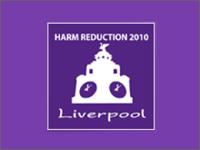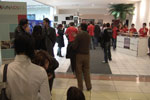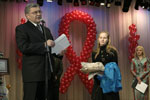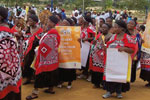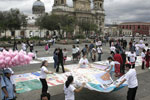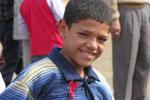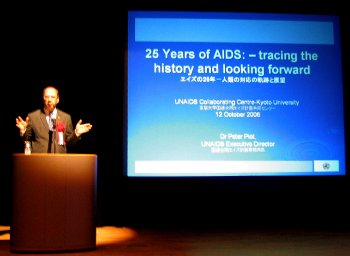To view the pictures from World Aids Day events you require the Flash Plugin Download it here.
World AIDS Day 2006 commemoration at UNAIDS/WHO
The World AIDS Day celebration at UNAIDS/WHO Headquarters in Geneva, was organized by the UN family, missions, NGO's, humanitarian organizations, people living with HIV and faith communities. The lighting and placing of red candles forming a ribbon and the signing of promises onto a commemorative ribbon were two of the activities that took place after the opening remarks by Dr. Peter Piot, Executive Director, UNAIDS and other special guests.
View pictures
World AIDS Day 2006 commemoration in Nigeria
UNAIDS coordinated the UN support to the WAD ceremony, including exhibition stands with condom promotion and demonstration and drama performances. UNAIDS and UN staff also participated in the rally of PLHIV to the National Assembly and to the office of the Minister of the Federal Capital Territory.
View pictures
World AIDS Day 2006 commemoration in South Africa
The UNAIDS Country Office in South Africa in partnership with Cricket South Africa uses sport as a platform for promotion of HIV Prevention. The pictures were taken during . UNAIDS and Cricket South Africa decided to use the Standard Bank International Pro20 Cricket Match between South Africa and India played in Johannesburg, South Africa on the 1st of December 2006 to commemorate World AIDS Day.
The Captain of the South Africa Cricket Team – Graeme Smith gave a speech on the impact of HIV in South Africa, the need to support people living with HIV, and the importance of knowing your HIV status.
Public Service Announcements (PSAs) from the World AIDS Campaign were also broadcasted during the match (as shown in pictures)
View pictures
World AIDS Day 2006 commemoration in Panama
UNAIDS RST Office for Latin America in coordination with UNAIDS Panama carried out two visibility events for the commemoration of the WAD. One was carried out in the Miraflores Locks of the Panama Canal and the other at the Tocumen International Airport.
View pictures
World AIDS Day 2006 commemoration in Papua New Guinea
The World AIDS Day was a symbolic event in Port Moresby used as a platform to promote HIV testing and counseling under the national theme “Stop AIDS: You have the right to know’. The national preparations for the 2006 World AIDS Day were facilitated by the civil society umbrella body PACSO (PNG Alliance of Civil Society Organization) which is supported by UNAIDS-PNG.
View pictures
World AIDS Day 2006 commemoration in Macedonia
The World AIDS Day in Macedonia was organised jointly by UNAIDS, the Ministry of Health and local NGOs, and took place in a shopping Mall in its capital, Skopje. There were two info-educational stands where young people from local NGOs offered information on AIDS prevention and distributed booklets, condoms and red ribbons to all visitors, while mobile NGO teams circulated throughout the mall attracting people to write massages that were used to create a “Red message Ribbon”. During the WAD, a photographic exhibition on AIDS, consisting of 40 photographs made by young people, was also inaugurated.
View pictures
World AIDS Day 2006 commemoration in Belarus
UNAIDS supported the Belarusian Youth Festival of Universities “Stop AIDS. Keep the Promise” held in Minsk 1 December 2006. The Youth Festival was organized by all Universities within the National Plan of Actions on the World AIDS Day 2006. Every University contributed to the Festival with their projects on anti-stigma, health behavior and life skills. The Festival was opened by the Vice-Minister of the Ministry of Health.
Another WAD activity sponsored by UNAIDS was the “Leave Positively!” event organized by the NGO of PLHIV “Positive Movement”. The event scenario was centered around a concert where participants wrote messages to PLHIV. The exhibition of the Red Bells messages will start a tour among self-support groups of PLHIV all over Belarus.
View pictures
World AIDS Day 2006 commemoration in Burundi
The commemoration of the World AIDS Day 2006 in Burundi extended to all 17 provinces of the country. The Burundi Alliance against AIDS (ABS), a network of 140 national associations, mobilized its members across the country to work closely with the provincial governments to organize World AIDS Day events and present their achievements from the past year. Delegations of high government representatives visited all provinces of the country, where communal ceremonies included parades, film screenings, photo exhibits, sports competitions and cultural performances. Delegates from networks of people living with HIV, the National Alliance against AIDS, and Women and Youth groups addressed local audiences. The President of the Republic launched the National Strategic Plan for 2007-2011.
View pictures
World AIDS Day 2006 commemoration in Lesotho
The World AIDS Day commemoration in Lesotho was marked by the support of King Letsie III to the national plans to address AIDS in the country. The King also launched the first ever "Know Your Status" campaign during the World AIDS Day commemorations .
View pictures
World AIDS Day 2006 commemoration in Swaziland
The UNAIDS Country Office in Swaziland in partnership with the Swaziland Government, the national AIDS coordinating body, as well as several national and international NGOs working in Swaziland commemorated World AIDS Day with a Ten Day Campaign leading up to the climax day on December 1st. During the campaign offices across the country displayed candles with the red ribbon and promises boxes where people were encouraged to make a pledge and keep the promise. On December 1st a march and run were held to commemorate World AIDS Day 2006. The event also featured songs by the traditional women’s regiment (Lutsango), dramas and songs by school children, music, and dance all focused on HIV. There were also information booths by NGOs working on HIV in the country, and mobile testing units in line with the focus on HIV Prevention.
View pictures
World AIDS Day 2006 commemoration in Thailand
UN agencies and civil society organisations teamed up to organise a World AIDS Day event led by UNESCO and Thai Red Cross. The event, which took place at Lumpini Park and Thai Red Cross Compound in Bangkok on the 1st of December 2006 was billed as the “Condom Chain of Life Festival” and included setting a new Guinness Book of Records mark for the world’s longest chain of condoms intended to raise awareness around HIV prevention. The World AIDS Day commemoration included a parade organized by the Thai Red Cross involving HRH Princess Somsawalee, games, activities and performances around AIDS issues. Tents and pavilions were organized by UN agencies and NGOs working on HIV related issues to disseminate information.
View pictures
World AIDS Day 2006 commemoration in Guatemala
To commmemorate The International World AIDS Day 2006, El Día Mundial en la lucha contra el SIDA, the activity of Quilts in the Central Park, in front of Palacio Nacional de la Cultura, Guatemala City, Guatemala, C.A.
View pictures
World AIDS Day 2006 commemoration in Egypt
As part of the Sailing the Nile for the Millenium Development Goals (MDGs) project, initiated by the UN and its partners, eight felucca boats, each representing a Goal, sail the Nile to promote action to fulfill the MDGs in Egypt. On December 1st, the boats stopped in Beni-Suef to promote the 6th MDG, that aims to combat HIV, malaria and other diseases, and to commemorate World AIDS Day. The organised events included HIV education training-of-trainers sessions with youth and the promotion of volunteerism; workshops with religious leaders to spread AIDS awareness messages; and welcome the feluccas with a parade, display of banners, song and dance performances. In addition to the activities planned in Beni-Suef, AIDS awareness campaigns were orchestrated by local organizations in Cairo, Sohag, Qena, Luxor, Aswan, and Assiut, with events ranging from awareness-raising and training-of-trainers to competitive sports and dramatic performances.
View pictures




